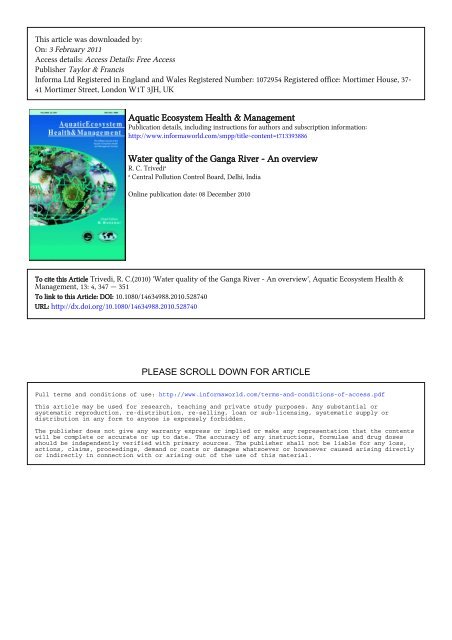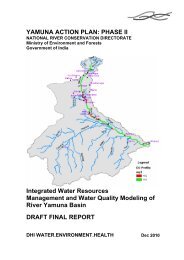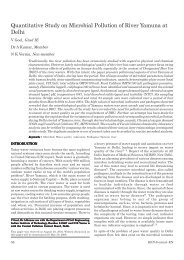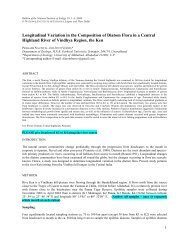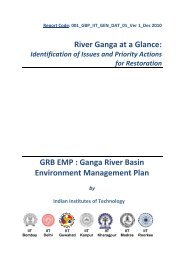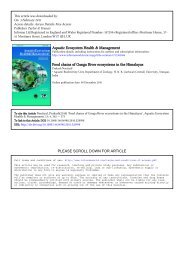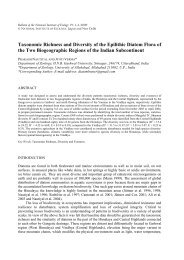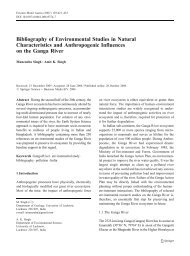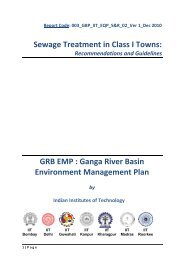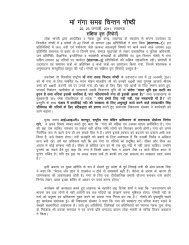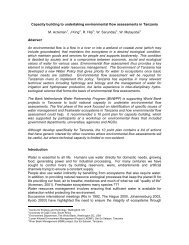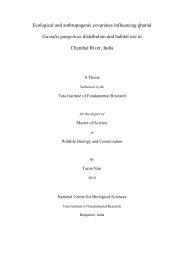Water quality of the Ganga River – An overview.pdf - GANGAPEDIA
Water quality of the Ganga River – An overview.pdf - GANGAPEDIA
Water quality of the Ganga River – An overview.pdf - GANGAPEDIA
Create successful ePaper yourself
Turn your PDF publications into a flip-book with our unique Google optimized e-Paper software.
This article was downloaded by:<br />
On: 3 February 2011<br />
Access details: Access Details: Free Access<br />
Publisher Taylor & Francis<br />
Informa Ltd Registered in England and Wales Registered Number: 1072954 Registered <strong>of</strong>fice: Mortimer House, 37-<br />
41 Mortimer Street, London W1T 3JH, UK<br />
Aquatic Ecosystem Health & Management<br />
Publication details, including instructions for authors and subscription information:<br />
http://www.informaworld.com/smpp/title~content=t713393886<br />
<strong>Water</strong> <strong>quality</strong> <strong>of</strong> <strong>the</strong> <strong>Ganga</strong> <strong>River</strong> - <strong>An</strong> <strong>overview</strong><br />
R. C. Trivedi a<br />
a Central Pollution Control Board, Delhi, India<br />
Online publication date: 08 December 2010<br />
To cite this Article Trivedi, R. C.(2010) '<strong>Water</strong> <strong>quality</strong> <strong>of</strong> <strong>the</strong> <strong>Ganga</strong> <strong>River</strong> - <strong>An</strong> <strong>overview</strong>', Aquatic Ecosystem Health &<br />
Management, 13: 4, 347 — 351<br />
To link to this Article: DOI: 10.1080/14634988.2010.528740<br />
URL: http://dx.doi.org/10.1080/14634988.2010.528740<br />
PLEASE SCROLL DOWN FOR ARTICLE<br />
Full terms and conditions <strong>of</strong> use: http://www.informaworld.com/terms-and-conditions-<strong>of</strong>-access.<strong>pdf</strong><br />
This article may be used for research, teaching and private study purposes. <strong>An</strong>y substantial or<br />
systematic reproduction, re-distribution, re-selling, loan or sub-licensing, systematic supply or<br />
distribution in any form to anyone is expressly forbidden.<br />
The publisher does not give any warranty express or implied or make any representation that <strong>the</strong> contents<br />
will be complete or accurate or up to date. The accuracy <strong>of</strong> any instructions, formulae and drug doses<br />
should be independently verified with primary sources. The publisher shall not be liable for any loss,<br />
actions, claims, proceedings, demand or costs or damages whatsoever or howsoever caused arising directly<br />
or indirectly in connection with or arising out <strong>of</strong> <strong>the</strong> use <strong>of</strong> this material.
Downloaded At: 04:54 3 February 2011<br />
<strong>Water</strong> <strong>quality</strong> <strong>of</strong> <strong>the</strong> <strong>Ganga</strong> <strong>River</strong> <strong>–</strong> <strong>An</strong> <strong>overview</strong><br />
R. C. Trivedi<br />
Central Pollution Control Board, East Arjun Nagar, Delhi <strong>–</strong> 110 032, India<br />
dr r c trivedi@rediffmail.com<br />
The <strong>Ganga</strong> is not only a holy river, but also a lifeline <strong>of</strong> a large population <strong>of</strong> India, as it covers more than<br />
26% <strong>of</strong> <strong>the</strong> country’s area in its basin in <strong>the</strong> north and drains 25% <strong>of</strong> <strong>the</strong> annual run-<strong>of</strong>f. Fast urbanization,<br />
industrialization and steep demand for water have led to serious problems <strong>of</strong> water <strong>quality</strong> degradation.<br />
<strong>Water</strong> <strong>quality</strong> monitoring indicated that <strong>the</strong> river is polluted in some <strong>of</strong> <strong>the</strong> segments, <strong>the</strong> worst affected<br />
lying between Kannauj and Allahabad, approximately 350 km long. About 12,222 million litres per day<br />
(mld) <strong>of</strong> domestic and 2500 mld <strong>of</strong> industrial wastewater is generated in <strong>the</strong> entire basin, out <strong>of</strong> which<br />
about 2573 mld <strong>of</strong> wastewater is generated along its bank. Many <strong>of</strong> its tributaries are heavily polluted<br />
and <strong>the</strong> main water <strong>quality</strong> issues are, organic pollution indicated by BOD and pathogens indicated by<br />
coliform count. There is a fluctuating trend <strong>of</strong> water <strong>quality</strong> attributed to <strong>the</strong> flow conditions in <strong>the</strong> river<br />
which depend on rainfall and water abstraction. In view <strong>of</strong> water scarcity in <strong>the</strong> basin, it is very important<br />
that no wastewater be discharged into <strong>the</strong> river. There is an urgent need to augment water availability in<br />
<strong>the</strong> basin by rainwater collection, water conservation and environmental flow determination in various<br />
segments <strong>of</strong> <strong>the</strong> river affected by water abstraction.<br />
Keywords: Domestic wastewater, pathogenic pollution, over-exploitation, integrated water resources<br />
management<br />
Introduction<br />
The <strong>Ganga</strong> is <strong>the</strong> largest and <strong>the</strong> most important<br />
river <strong>of</strong> India, and it is no wonder that it serves as<br />
<strong>the</strong> cradle <strong>of</strong> <strong>the</strong> Indian civilization. Roughly 40%<br />
<strong>of</strong> <strong>the</strong> population <strong>of</strong> India lives in <strong>the</strong> <strong>River</strong> <strong>Ganga</strong><br />
basin. The waters <strong>of</strong> <strong>the</strong> <strong>River</strong> <strong>Ganga</strong> are extensively<br />
used for domestic, industrial and agricultural<br />
purposes. A large number <strong>of</strong> people ba<strong>the</strong> in its<br />
sacred waters because <strong>of</strong> its great religious significance.<br />
In <strong>the</strong> recent past, due to rapid population<br />
growth, fast urbanization and industrialization, <strong>the</strong><br />
quantities <strong>of</strong> wastewater and solid waste discharged<br />
into <strong>the</strong> river are increasing and problems <strong>of</strong> water<br />
pollution are emerging. In particular, <strong>the</strong> type <strong>of</strong><br />
pollution that causes water-borne diseases through<br />
pathogenic microorganisms is a major social prob-<br />
347<br />
lem for <strong>the</strong> Indian people who have frequent contact<br />
with <strong>the</strong> river. This manuscript presents <strong>the</strong> water<br />
<strong>quality</strong> data based on monitoring <strong>of</strong> <strong>the</strong> <strong>River</strong><br />
<strong>Ganga</strong> over <strong>the</strong> last few decades by a national agency<br />
(CPCB, 1978, 1982, 2006, 2008).<br />
<strong>Ganga</strong> Basin<br />
The <strong>Ganga</strong> basin covers slightly more than onefourth<br />
(26.3%) <strong>of</strong> <strong>the</strong> country’s total geographical<br />
area, and is <strong>the</strong> biggest river basin. The <strong>Ganga</strong> originates<br />
as Bhagirathi from <strong>the</strong> Gangotri Glaciers in <strong>the</strong><br />
Himalaya in <strong>the</strong> Uttarkashi district <strong>of</strong> Uttarakhand<br />
State in India. The Bhagirathi is joined by <strong>the</strong> Alaknanda<br />
at Deoprayag. The <strong>River</strong> <strong>Ganga</strong> flows through<br />
<strong>the</strong> rest <strong>of</strong> <strong>the</strong> mountain region and debouches into<br />
<strong>the</strong> plains at Haridwar. It is joined by a large number<br />
<strong>of</strong> tributaries on both <strong>the</strong> banks in <strong>the</strong> 2,525 km long<br />
Aquatic Ecosystem Health & Management, 13(4):347<strong>–</strong>351, 2010. Copyright C○ 2010 AEHMS. ISSN: 1463-4988 print / 1539-4077 online<br />
DOI: 10.1080/14634988.2010.528740
Downloaded At: 04:54 3 February 2011<br />
348 Trivedi / Aquatic Ecosystem Health and Management 13 (2010) 347<strong>–</strong>351<br />
course to <strong>the</strong> Bay <strong>of</strong> Bengal. The <strong>Ganga</strong> basin is part<br />
<strong>of</strong> <strong>the</strong> composite <strong>Ganga</strong>-Brahmputra-Meghna basin<br />
which lies in China, Nepal, India and Bangladesh<br />
and drains an area <strong>of</strong> 1,086,000 sq.km. Out <strong>of</strong> this<br />
basin area, 861,000 km 2 , or roughly 80%, is located<br />
in India. It is bounded on <strong>the</strong> north by <strong>the</strong> Himalayas,<br />
on <strong>the</strong> west by <strong>the</strong> Aravalli as well as <strong>the</strong><br />
ridge separating it from <strong>the</strong> Indus basin, on <strong>the</strong> south<br />
by <strong>the</strong> Vindhyas and Chhotanagpur Plateau and on<br />
<strong>the</strong> east by <strong>the</strong> Brahmaputra ridge. In India, <strong>the</strong><br />
basin covers <strong>the</strong> whole <strong>of</strong> Uttar Pradesh, (240,798<br />
km 2 ), Uttarakhand (53,566), Bihar (143,961 km 2 ),<br />
West Bengal (71,485 km 2 ) and Delhi (1,484 km 2 ),<br />
and part <strong>of</strong> Madhya Pradesh (198,962 km 2 ), Rajasthan<br />
(112,490 km 2 ), Haryana (34,341 km 2 ) and<br />
Himachal Pradesh (4,317 km 2 ). There are many important<br />
holy cities and towns situated on <strong>the</strong> banks<br />
<strong>of</strong> <strong>the</strong> <strong>Ganga</strong> which attract people from all over <strong>the</strong><br />
country and abroad.<br />
<strong>River</strong> Flow<br />
Due to <strong>the</strong> typical patterns <strong>of</strong> rainfall being restricted<br />
to only about 3 months during a year in <strong>the</strong><br />
basin, <strong>the</strong> dry season flow in <strong>the</strong> <strong>Ganga</strong> and its tributaries<br />
is only a fraction <strong>of</strong> <strong>the</strong> total annual flow.<br />
This flow has been seriously affected in <strong>the</strong> recent<br />
past due to over-abstraction <strong>of</strong> groundwater in <strong>the</strong><br />
basin, which has a marked effect on water <strong>quality</strong> <strong>of</strong><br />
<strong>the</strong> river. Such low discharge rates call for extreme<br />
precaution and control <strong>of</strong> water pollution, during<br />
<strong>the</strong> dry period in particular. In <strong>the</strong> upper stretch <strong>of</strong><br />
<strong>the</strong> river <strong>the</strong> natural flow is affected due to hydroelectric<br />
dams. Therefore, <strong>the</strong> issue <strong>of</strong> maintaining<br />
ecological flows in <strong>the</strong> river is becoming a serious<br />
problem in view <strong>of</strong> conflicting and competing uses<br />
<strong>of</strong> <strong>the</strong> water.<br />
Tributaries<br />
The <strong>Ganga</strong> has a large number <strong>of</strong> tributaries;<br />
some <strong>of</strong> <strong>the</strong>se are <strong>of</strong> Himalayan origin with considerably<br />
large water wealth. The important tributaries<br />
within India are <strong>the</strong> Kali, <strong>the</strong> Ramganga, <strong>the</strong> Yamuna,<br />
<strong>the</strong> Gomti, <strong>the</strong> Ghaghara, <strong>the</strong> Gandak and<br />
<strong>the</strong> Kosi. The Yamuna, although a tributary <strong>of</strong> <strong>the</strong><br />
<strong>Ganga</strong>, is virtually a river by itself. Its major tributaries<br />
are <strong>the</strong> Chambal, <strong>the</strong> Sind, <strong>the</strong> Betwa and <strong>the</strong><br />
Ken. The main plateau tributaries <strong>of</strong> <strong>the</strong> <strong>Ganga</strong> are<br />
<strong>the</strong> Tons, <strong>the</strong> Son, <strong>the</strong> Damodar and <strong>the</strong> Kasai-Haldi.<br />
Major Sources <strong>of</strong> Pollution<br />
Domestic wastes<br />
The major source <strong>of</strong> pollution is discharge <strong>of</strong><br />
untreated domestic wastewater from <strong>the</strong> fast growing<br />
large urban centres located along <strong>the</strong> river. It is<br />
mostly organic waste, sewage, trash, food, and human<br />
and animal remains. Over <strong>the</strong> past few decades,<br />
urban populations along <strong>the</strong> Ganges have grown at<br />
a tremendous rate, while waste-control infrastructure<br />
has remained relatively unchanged. The sacred<br />
practice <strong>of</strong> depositing human remains in <strong>the</strong> Ganges<br />
also poses health threats because <strong>of</strong> <strong>the</strong> unsustainable<br />
rate at which partially cremated cadavers are<br />
dumped. Thousands <strong>of</strong> cremations are performed<br />
every day along <strong>the</strong> river, most on wood pyres that<br />
do not completely consume <strong>the</strong> body. Along with<br />
<strong>the</strong> remains <strong>of</strong> <strong>the</strong>se traditional funerals, <strong>the</strong>re are<br />
thousands more who cannot afford cremation and<br />
whose bodies are simply thrown into <strong>the</strong> Ganges.<br />
In addition, <strong>the</strong> carcasses <strong>of</strong> thousands <strong>of</strong> dead cattle,<br />
which are sacred to Hindus, go into <strong>the</strong> river<br />
each year. <strong>An</strong> inadequate cremation procedure contributes<br />
to a large number <strong>of</strong> partially burned or<br />
unburned corpses floating down <strong>the</strong> <strong>Ganga</strong>.<br />
Domestic wastewater, which is <strong>the</strong> major source<br />
<strong>of</strong> pollution <strong>of</strong> <strong>the</strong> river is contributed from <strong>the</strong><br />
larger cities/towns, especially Class-I cities (population<br />
over 100,000) and Class-II towns (population<br />
50,000<strong>–</strong>100,000). The smaller towns and villages<br />
generally do not contribute any significant<br />
wastewater. There are 179 Class I cities and 148<br />
Class II towns in <strong>the</strong> basin. The recent survey <strong>of</strong><br />
Class I cities and Class II towns carried out by Central<br />
Pollution Control Board, Government <strong>of</strong> India<br />
(CPCB, 2006) indicated that about 12,222 million<br />
liter day −1 (MLD) <strong>of</strong> wastewater are generated in<br />
<strong>the</strong> <strong>Ganga</strong> basin out <strong>of</strong> which treatment facilities<br />
are only available for 4050 MLD. Thus <strong>the</strong>re is a<br />
large gap between <strong>the</strong> wastewater generation and<br />
treatment capacity (Tables 1 and 2).<br />
The <strong>Ganga</strong> Action Plan<br />
The treatment <strong>of</strong> domestic wastewater is <strong>the</strong> responsibility<br />
<strong>of</strong> <strong>the</strong> urban local bodies (ULBs) under<br />
<strong>the</strong> Constitution <strong>of</strong> India. However, due to a<br />
paucity <strong>of</strong> resources <strong>the</strong>y are not able to fulfill this<br />
responsibility and so a large amount <strong>of</strong> wastewater<br />
is not being treated but still being discharged into<br />
<strong>the</strong> rivers, causing significant pollution. Realizing
Downloaded At: 04:54 3 February 2011<br />
Trivedi / Aquatic Ecosystem Health and Management 13 (2010) 347<strong>–</strong>351 349<br />
Table 1. Disposal <strong>of</strong> Wastewater in <strong>Ganga</strong> Basin, from Class-I cities and Class-II towns.<br />
Class-I Cities Class-II Towns Total<br />
Volume <strong>of</strong> Volume <strong>of</strong> Volume <strong>of</strong><br />
Wastewater, Wastewater, Wastewater,<br />
Mode <strong>of</strong> Disposal Number MLD Number MLD Number MLD<br />
Into <strong>the</strong> <strong>Ganga</strong> <strong>River</strong> 36 2442.1 15 130.5 51 2572.6<br />
Into <strong>the</strong> tributaries 113 7841.5 17 126.0 130 7967.5<br />
On to land for irrigation 30 907.4 116 774.8 146 1682.2<br />
Grand Total 179 11,191.0 148 1031.3 327 12,222.3<br />
<strong>the</strong> importance <strong>of</strong> <strong>the</strong> <strong>Ganga</strong> <strong>River</strong>, <strong>the</strong> Government<br />
<strong>of</strong> India has launched <strong>Ganga</strong> Action Plan (GAP)<br />
to assist <strong>the</strong> ULBs to install treatment plants in <strong>the</strong><br />
27 priority towns along <strong>the</strong> <strong>Ganga</strong> <strong>River</strong> to restore<br />
its water <strong>quality</strong>. In Phase-I <strong>of</strong> <strong>the</strong> GAP a treatment<br />
capacity <strong>of</strong> 870 MLD was created (Ministry<br />
<strong>of</strong> Environment and Forests, Government <strong>of</strong> India,<br />
2009, http://www. envfor.nic.in/nrcd). Subsequently<br />
in Phase-II <strong>of</strong> <strong>the</strong> GAP, an additional capacity <strong>of</strong><br />
130 MLD was created in 48 smaller towns along <strong>the</strong><br />
river. Similarly, a treatment capacity <strong>of</strong> 720 MLD<br />
was created under <strong>the</strong> Yamuna Action Plan, (YAP)<br />
and a capacity <strong>of</strong> 2330 MLD was created by Government<br />
<strong>of</strong> Delhi for restoration <strong>of</strong> water <strong>quality</strong> in<br />
<strong>the</strong> Yamuna <strong>River</strong>. However, due to fast urbanization<br />
<strong>the</strong>se efforts were not adequate to achieve <strong>the</strong><br />
clean <strong>Ganga</strong> target. <strong>Water</strong> scarcity resulting from<br />
over-abstraction <strong>of</strong> surface and groundwater in <strong>the</strong><br />
basin due to <strong>the</strong> fast increase in water demand is<br />
ano<strong>the</strong>r serious issue which needs to be addressed.<br />
In order to effectively use <strong>the</strong> facilities created, it<br />
is important that <strong>the</strong> treatment plants are used efficiently.<br />
Due to <strong>the</strong> paucity <strong>of</strong> resources <strong>the</strong> treatment<br />
plants created under GAP or YAP are not effectively<br />
utilized in <strong>the</strong> majority <strong>of</strong> cases leading to no<br />
marked impact on improvement in water <strong>quality</strong> <strong>of</strong><br />
Table 2. Sewage Treatment.<br />
1. Sewage Treatment capacity<br />
created under <strong>Ganga</strong> Action Plan<br />
Phase-I<br />
2. Sewage treatment capacity<br />
created along <strong>the</strong> Yamuna<br />
3. Additional towns (48 towns)<br />
where sewage treatment capacity<br />
is being created under GAP<br />
Phase-II<br />
870 MLD<br />
3050 MLD<br />
130 MLD<br />
<strong>the</strong> rivers. Therefore, an integrated water resources<br />
management plan needs to be implemented ra<strong>the</strong>r<br />
than just provision <strong>of</strong> wastewater treatment facilities.<br />
Industrial Sources<br />
It is estimated that <strong>the</strong> amount <strong>of</strong> industrial<br />
wastewater by volume is about 2500 MLD, or<br />
20% <strong>of</strong> <strong>the</strong> total volume <strong>of</strong> wastewater generated<br />
in <strong>the</strong> <strong>Ganga</strong> Basin. The most important industrial<br />
pollution source is from Uttar Pradesh (nearly<br />
55%) followed by Haryana, Madhya Pradesh, Rajasthan,<br />
West Bengal and o<strong>the</strong>rs. The major industrial<br />
towns located along <strong>the</strong> river are Kanpur (tanneries),<br />
Kolkata (tanneries), Allahabad (engineering)<br />
and Varanasi (carpets and locomotive); whereas<br />
on its tributaries Yamunanagar (paper, sugar and<br />
distilleries), Panipat (distilleries, fertilizer, textiles),<br />
Sonepat, (enginnering, tanneries, paper) Gurgaon<br />
(paper, aumobile), Faridabad (engineering, automobile,<br />
home appliances), Indore (textiles, automobiles,<br />
pharmaceuticals), Dewas (security paper<br />
mills, textiles), Nagda (rayon, caustic soda plant),<br />
Ujjain (textiles), Muzaffarnagar (sugar and distilleries),<br />
Modinagar (sugar and distilleries), Ghaziabad<br />
(home appliance, distillery), Mathura (textile,<br />
refinery), Agra (foundries, petha industries),<br />
Meerut (sugar and distilleries), Aligarh (engineering),<br />
Noida (enginnering), Rampur (sugar and distilleries),<br />
Kashipur (sugar, distilleries, pharmaceutical),<br />
Kota (rayon, fertilizer, chemicals), Udaipur<br />
(cement, zinc smeler), Bhilwara (textile), Bokaro<br />
(steel and <strong>the</strong>rmal power), Dhanbad (<strong>the</strong>rmal power,<br />
coal mines), Asansol (distillery, pharmaceutical,<br />
food) and Durgapur (steel, <strong>the</strong>rmal power) are<br />
<strong>the</strong> major towns. The industries are mainly agrobased;<br />
i.e. sugar, distilleries, paper, (small and large)
Downloaded At: 04:54 3 February 2011<br />
350 Trivedi / Aquatic Ecosystem Health and Management 13 (2010) 347<strong>–</strong>351<br />
tanneries, textiles, engineering, automobiles, <strong>the</strong>rmal<br />
power, fertilizer plants, pharmaceuticals and<br />
refineries. Most industries have adopted <strong>the</strong> treatment<br />
facilities. However, correct operation <strong>of</strong> <strong>the</strong><br />
treatment facilities has to be ensured. There is a<br />
large number <strong>of</strong> small scale industries located in<br />
residential areas <strong>of</strong> almost all <strong>the</strong> cities/towns or<br />
even villages in <strong>the</strong> basin. For such industries provision<br />
<strong>of</strong> treatment is a problem, as <strong>the</strong> space is <strong>of</strong>ten<br />
not available. Moreover, <strong>the</strong> land is gradually becoming<br />
scarce and precious in <strong>the</strong> urban areas and<br />
<strong>the</strong>refore mostly not available for treatment.<br />
Agriculture<br />
The agricultural activities in <strong>the</strong> <strong>Ganga</strong> Basin<br />
are quite advanced and fertilizer and pesticide consumption<br />
is quite significant. However, <strong>the</strong>re is no<br />
recent data on <strong>the</strong>ir consumption. The <strong>Ganga</strong> basin<br />
survey (CPCB, 1982-83) reported that almost 33.8%<br />
<strong>of</strong> India’s annual consumption, which means about<br />
6.8 million tonnes <strong>of</strong> fertilizers and about 33,800<br />
tonnes <strong>of</strong> various kinds <strong>of</strong> pesticides, are used in<br />
<strong>the</strong> basin. The application <strong>of</strong> fertilizer and pesticides<br />
per hectare <strong>of</strong> land varies tremendously and is<br />
higher in <strong>the</strong> alluvial plains, which is agriculturally<br />
more advanced here. However, agro-chemicals as a<br />
source <strong>of</strong> pollution is not very significant due to <strong>the</strong><br />
fact that <strong>the</strong>se chemicals only contribute to <strong>the</strong> river<br />
when <strong>the</strong>re is surface run-<strong>of</strong>f, and <strong>the</strong>re are few run<strong>of</strong>f<br />
events as on an average <strong>the</strong>re are only 40 rainy<br />
days per year. During rainy days <strong>the</strong> river is also<br />
in spate and significant dilution is available. Hence<br />
pollution due to agro-chemicals is not significantly<br />
detected in <strong>the</strong> river.<br />
<strong>Water</strong> Quality Monitoring<br />
The water <strong>quality</strong> monitoring <strong>of</strong> <strong>the</strong> river<br />
<strong>Ganga</strong> is carried out at 20 locations as depicted<br />
in Figure 1 (Figure 1 available at www.aehms.<br />
org/Journal/13 4 Trivedi Appendix.html) and in its<br />
several tributaries, as well as in some locations on<br />
lakes, canals and drains in <strong>the</strong> basin, by <strong>the</strong> State Pollution<br />
Control Boards <strong>of</strong> Uttar Pradesh, Bihar, West<br />
Bengal, Rajasthan and Madhya Pradesh, as well as<br />
by <strong>the</strong> Central Pollution Control Board at 101 locations.<br />
Monitoring is done on a monthly basis and <strong>the</strong><br />
data analysed and put on a web-site. CPCB also publishes<br />
an <strong>An</strong>nual <strong>Water</strong> Quality Statistics <strong>of</strong> India<br />
(CPCB 1992 to 2007).<br />
<strong>Water</strong> Quality Status<br />
The last 25 years <strong>of</strong> monitoring water <strong>quality</strong> by<br />
CPCB indicated that organic and pathogenic pollution<br />
are <strong>the</strong> most evident as indicated by high<br />
Biochemical Oxygen Demand (BOD) and coliform<br />
counts in <strong>the</strong> river. The BOD level at several locations<br />
between Haridwar and Tarighat is more than<br />
<strong>the</strong> desirable limit <strong>of</strong> 3 milligrams per liter. In <strong>the</strong><br />
stretch between Kannauj and Kanpur, BOD <strong>of</strong>ten<br />
rises to a high level <strong>of</strong> 5 to 8 milligrams per liter, due<br />
to episodic pollution arising from <strong>the</strong> industries in<br />
<strong>the</strong> Kali <strong>River</strong> and Ramganga <strong>River</strong> Basins. Despite<br />
intensive use <strong>of</strong> water, heavy withdrawals and substantial<br />
discharges <strong>of</strong> domestic and industrial wastes<br />
throughout its course, <strong>the</strong> <strong>Ganga</strong> water shows a considerable<br />
amount <strong>of</strong> resilience as far as pollution is<br />
concerned and <strong>the</strong> dissolved oxygen (DO) along <strong>the</strong><br />
entire course shows a remarkably stable and healthy<br />
pattern. The oxygen content never falls below <strong>the</strong><br />
critical level <strong>of</strong> 5 milligrams per liter. The water<br />
<strong>quality</strong> in terms <strong>of</strong> Fecal Coliform (FC) count has<br />
been poor virtually all along <strong>the</strong> river downstream <strong>of</strong><br />
Haridwar. From Kannauj to Trighat <strong>the</strong> FC content<br />
was found to be high upstream, <strong>the</strong> most probable<br />
number (MPN) ranging from 900 to 150,000 per 100<br />
mililiters. Since this is much above <strong>the</strong> critical limit<br />
prescribed for <strong>the</strong> designated best use, i.e. ‘Outdoor<br />
Bathing’ <strong>of</strong> <strong>Ganga</strong> water in this stretch, it calls for<br />
serious attention. Again, in <strong>the</strong> lower reaches <strong>of</strong> <strong>the</strong><br />
Hugli, especially below Palta, very high levels <strong>of</strong><br />
<strong>the</strong> fecal coliform organisms are observed: 7500 to<br />
295,000 MPN 100 ml −1 . Despite <strong>the</strong> fact that <strong>the</strong><br />
ambient water <strong>quality</strong> <strong>of</strong> <strong>the</strong> <strong>Ganga</strong> is ra<strong>the</strong>r poor at<br />
many segments, <strong>the</strong> river is actually being used as<br />
if it is <strong>of</strong> higher grade, through outdoor bathing by<br />
<strong>the</strong> millions <strong>of</strong> people who take holy dips throughout<br />
<strong>the</strong> course <strong>of</strong> <strong>the</strong> river, from Gangotri to <strong>Ganga</strong><br />
Sagar.<br />
From <strong>the</strong> above information on water <strong>quality</strong> <strong>of</strong><br />
<strong>the</strong> <strong>Ganga</strong>, it is revealed that <strong>the</strong> stretches from<br />
Kanpur to Patna and from Nabadwip to Diamond<br />
Harbour are <strong>of</strong> concern. Although DO content <strong>of</strong><br />
<strong>the</strong> river water in <strong>the</strong>se stretches is well above 5<br />
milligrams per liter, BOD and fecal coliform levels<br />
are considerably high, suggesting that <strong>the</strong> municipal<br />
wastes from <strong>the</strong> towns need to be carefully tackled,<br />
and untreated wastes should not be allowed to be<br />
discharged into <strong>the</strong> river, in any case.<br />
Due to high BOD and FC in <strong>the</strong> river, especially<br />
along <strong>the</strong> city limits <strong>of</strong> Kanpur, Allahabad and<br />
Varanasi, <strong>the</strong> river is not fit for its designated best
Downloaded At: 04:54 3 February 2011<br />
Trivedi / Aquatic Ecosystem Health and Management 13 (2010) 347<strong>–</strong>351 351<br />
use <strong>of</strong> ‘Outdoor Bathing’. Never<strong>the</strong>less <strong>the</strong> river is<br />
intensively used in this stretch for sacred holy dips.<br />
Conclusions<br />
Fast urbanization and industrialization resulting<br />
in discharge <strong>of</strong> untreated or partially treated wastewater,<br />
coupled with massive abstraction <strong>of</strong> water for<br />
irrigation, industrial and domestic use, are <strong>the</strong> main<br />
causes <strong>of</strong> water <strong>quality</strong> degradation in <strong>the</strong> <strong>Ganga</strong><br />
<strong>River</strong>. No river can afford a situation where it is deprived<br />
<strong>of</strong> its flow and loaded with organic matter and<br />
nutrients. The efforts made to restore water <strong>quality</strong><br />
through <strong>the</strong> <strong>Ganga</strong> Action Plan were grossly inadequate,<br />
due to fast growth in <strong>the</strong> urban population<br />
along <strong>the</strong> river and lack <strong>of</strong> resources for operation<br />
and maintenance <strong>of</strong> <strong>the</strong> wastewater treatment facilities<br />
created. Moreover, <strong>the</strong> focus <strong>of</strong> <strong>the</strong> <strong>Ganga</strong> Action<br />
Plan was restricted to augmentation <strong>of</strong> wastewater<br />
treatment facilities only; <strong>the</strong>re were no efforts<br />
on water resources management, conservation or its<br />
judicious use. There is a need to implement an integrated<br />
water resources management plan in <strong>the</strong><br />
entire <strong>Ganga</strong> Basin in order to achieve water <strong>quality</strong><br />
targets, and ecological flows in <strong>the</strong> <strong>Ganga</strong> and its<br />
tributaries.<br />
References<br />
CPCB, 1978. Scheme <strong>of</strong> Zoning and Classification <strong>of</strong> Indian<br />
<strong>River</strong>s Estuaries and Coastal water (Pt. 1 Sweet <strong>Water</strong>),<br />
ADSORBS/3/1977-78, Central Pollution Control Board,<br />
Govt <strong>of</strong> India.<br />
CPCB, 1982. <strong>Ganga</strong> Basin Report ( Part-II Entire <strong>Ganga</strong> Basin)<br />
ADSORBS/7/19982-83, Central Pollution Control Board,<br />
Govt <strong>of</strong> India.<br />
CPCB, 2006. Status <strong>of</strong> Sewage Treatment in India. Central Pollution<br />
Control Board, Government <strong>of</strong> India: Control <strong>of</strong> Urban<br />
Pollution Series:CUPS/37/ 2005-2006.<br />
CPCB, 1992<strong>–</strong>2008. <strong>An</strong>nual <strong>Water</strong> Quality Statistics <strong>of</strong> India,<br />
1992 to 2008. Central Pollution Control Board, Government<br />
<strong>of</strong> India. Monitoring <strong>of</strong> Indian National Aquatic<br />
Resources Series: MINARS/7/1991-92, to MINARS /28 /<br />
2007-2008.<br />
CPCB, 2008. <strong>An</strong>nual <strong>Water</strong> Quality Statistics <strong>of</strong> India, from<br />
1994 to 2008. Central Pollution Control Board, Government<br />
<strong>of</strong> India. Monitoring <strong>of</strong> Indian National Aquatic Resources<br />
Series: MINARS/7/1991-92, to MINARS /28/2007-<br />
2008 http://www.envfor.nic.in/nrcd


